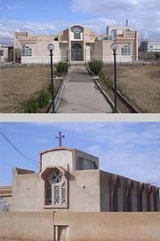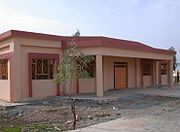
Sumail
Encyclopedia

Kurdish people
The Kurdish people, or Kurds , are an Iranian people native to the Middle East, mostly inhabiting a region known as Kurdistan, which includes adjacent parts of Iran, Iraq, Syria, and Turkey...
and Assyrian
Assyrian people
The Assyrian people are a distinct ethnic group whose origins lie in ancient Mesopotamia...
town located in the Iraq
Iraq
Iraq ; officially the Republic of Iraq is a country in Western Asia spanning most of the northwestern end of the Zagros mountain range, the eastern part of the Syrian Desert and the northern part of the Arabian Desert....
i province of Dohuk. The city is on the main road that connects Iraq
Iraq
Iraq ; officially the Republic of Iraq is a country in Western Asia spanning most of the northwestern end of the Zagros mountain range, the eastern part of the Syrian Desert and the northern part of the Arabian Desert....
to its neighbour Turkey
Turkey
Turkey , known officially as the Republic of Turkey , is a Eurasian country located in Western Asia and in East Thrace in Southeastern Europe...
. It is 14 kilometers west of the city of Dohuk
Dahuk, Iraq
Dohuk is the capital of Dahuk Governorate in Iraq. It has about 250.000 inhabitants, mostly consisting of Kurds, with an Assyrian minority...
.
Etymology
The town was mention by Yaqut al-HamawiYaqut al-Hamawi
Yāqūt ibn-'Abdullah al-Rūmī al-Hamawī) was an Islamic biographer and geographer renowned for his encyclopedic writings on the Muslim world. "al-Rumi" refers to his Greek descent; "al-Hamawi" means that he is from Hama, Syria, and ibn-Abdullah is a reference to his father's name, Abdullah...
as "Simwel" which is though to be a corruption of the Syriac Simmala meaning "left".
Another possible origin could be the Syriac Shmaʻ ʼIl , which means "listen lord".
History
The town was converted to Christianity in the 2nd century and was later famous for its Syrian manuscripts. Its Assyrian Christian inhabitants were split between the Syriac Orthodox ChurchSyriac Orthodox Church
The Syriac Orthodox Church; is an autocephalous Oriental Orthodox church based in the Eastern Mediterranean, with members spread throughout the world. The Syriac Orthodox Church claims to derive its origin from one of the first Christian communities, established in Antioch by the Apostle St....
and the Church of the East
Church of the East
The Church of the East tāʾ d-Maḏnḥāʾ), also known as the Nestorian Church, is a Christian church, part of the Syriac tradition of Eastern Christianity. Originally the church of the Persian Sassanid Empire, it quickly spread widely through Asia...
.
Its Christian inhabitants were forced out of the town by the Yazidis who settled the town in 1800. They were in turn massacred by Mir Muhammad of Rowanduz
Rowanduz
The town Rawandiz is a city of Iraq, which located in the sub-district of Soran, in the Arbil Governorate of Iraqi Kurdistan, close to the Iranian border.The population in 2003 was 95,089...
. Later on Arab tribes started settling the area.
Sumail in the early 20th century was a very small Kurd
Kürd
Kürd or Kyurd or Kyurt may refer to:*Kürd Eldarbəyli, Azerbaijan*Kürd Mahrızlı, Azerbaijan*Kürd, Goychay, Azerbaijan*Kürd, Jalilabad, Azerbaijan*Kürd, Qabala, Azerbaijan*Qurdbayram, Azerbaijan...
ish village. An Assyrian community formed in Sumail during World War I
World War I
World War I , which was predominantly called the World War or the Great War from its occurrence until 1939, and the First World War or World War I thereafter, was a major war centred in Europe that began on 28 July 1914 and lasted until 11 November 1918...
and the mass migration from the Hakkari
Hakkari
Hakkâri , is a city and the capital of the Hakkâri Province of Turkey. The name Hakkâri is derived from the Syriac word, Akkare, meaning farmers...
region of Turkey
Turkey
Turkey , known officially as the Republic of Turkey , is a Eurasian country located in Western Asia and in East Thrace in Southeastern Europe...
, due to the 1915 genocide
Assyrian genocide
The Assyrian Genocide refers to the mass slaughter of the Assyrian/Chaldean/Syriac population of the Ottoman Empire during the 1890s, the First World War, and the period of 1922-1925...
by the Ottoman Empire
Ottoman Empire
The Ottoman EmpireIt was usually referred to as the "Ottoman Empire", the "Turkish Empire", the "Ottoman Caliphate" or more commonly "Turkey" by its contemporaries...
against native Armenians
Armenians
Armenian people or Armenians are a nation and ethnic group native to the Armenian Highland.The largest concentration is in Armenia having a nearly-homogeneous population with 97.9% or 3,145,354 being ethnic Armenian....
and Assyrians
Assyrian people
The Assyrian people are a distinct ethnic group whose origins lie in ancient Mesopotamia...
.
Simele Massacre
The Assyrian peopleAssyrian people
The Assyrian people are a distinct ethnic group whose origins lie in ancient Mesopotamia...
who resided in Sumail and its neighbouring area were subjected to a massacre on August 7, 1933, this time implemented by the Iraqi government. The massacre was the first genocide in Iraq's young history after the establishment of the new Iraqi state in 1921. Between 600 to 3,000 Assyrians
Assyrian people
The Assyrian people are a distinct ethnic group whose origins lie in ancient Mesopotamia...
died during the 1933 massacre, most of them in the village of Sumail. Thousands were forced to flee to Syria
Syria
Syria , officially the Syrian Arab Republic , is a country in Western Asia, bordering Lebanon and the Mediterranean Sea to the West, Turkey to the north, Iraq to the east, Jordan to the south, and Israel to the southwest....
where they currently live in 33 villages of the Khabur
Khabur River
The Khabur River , , , ) is the largest perennial tributary to the Euphrates in Syrian territory. Although the Khabur originates in Turkey, the karstic springs around Ra's al-'Ayn are the river's main source of water. Several important wadis join the Khabur north of Al-Hasakah, together creating...
plains, in the Al Jazeera
Al-Jazira, Mesopotamia
Upper Mesopotamia is the name used for the uplands and great outwash plain of northwestern Iraq and northeastern Syria and southeastern Turkey which is known by the traditional Arabic name of Al-Jazira , variously transliterated into Roman script as Djazirah, Djezirah and Jazirah...
region.
People
The number of families in Sumail — Kurdish and Assyrian, Muslims and Christians — increased due to the geographical importance of the city and due to the destruction of smaller, nearby villages. Families were forced to migrate and to live in the larger cities and towns of the region.Having migrated from the neighbouring villages, most Sumailian families depend on agriculture for their income. Many villages in that area have plenty of seasonal water plants, tomatoes, and other vegetables. Many other people of Sumail depend on trade as their source of income.
In 1992, Dohuk University
University of Dohuk
Founded on the 31st of October 1992 with two colleges and a total of 149 students, University of Duhok includes now 13 colleges with more than 10000 undergraduate students and 500 Postgraduate students in different specializations. University of Duhok is a member of the International Association...
's College of Agriculture was founded in Sumail.
Around 170 Assyrian families currently live in Sumail centre. They are believers of the two main Christian churches in the region: the Chaldean Catholic Church
Chaldean Catholic Church
The Chaldean Catholic Church , is an Eastern Syriac particular church of the Catholic Church, maintaining full communion with the Bishop of Rome and the rest of the Catholic Church...
and the Assyrian Church of the East
Assyrian Church of the East
The Assyrian Church of the East, officially the Holy Apostolic Catholic Assyrian Church of the East ʻIttā Qaddishtā w-Shlikhāitā Qattoliqi d-Madnĕkhā d-Āturāyē), is a Syriac Church historically centered in Mesopotamia. It is one of the churches that claim continuity with the historical...
. The Chaldean church is named St. Mary the Virgin. The Assyrian church is named Church Of Martyrs (in the honour of the martyrs of the 1933 massacre of Sumail.) Around 12 Armenian families live in Sumail as well.
See also
- Simele massacreSimele massacreThe Simele Massacre was a massacre committed by the armed forces of the Kingdom of Iraq during the systematic targeting of Assyrians in northern Iraq in August 1933...
- List of Assyrian villages

